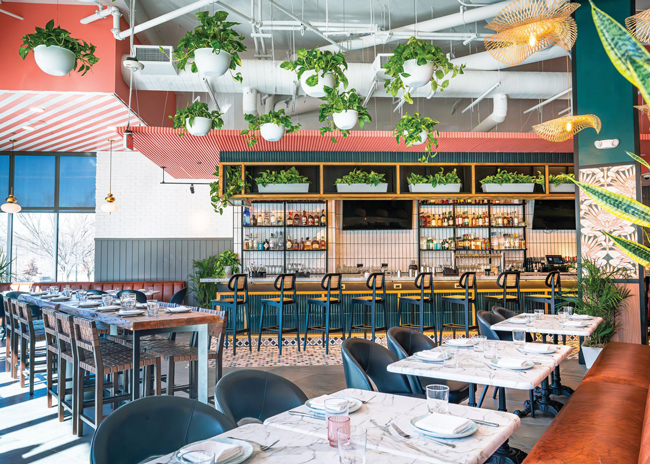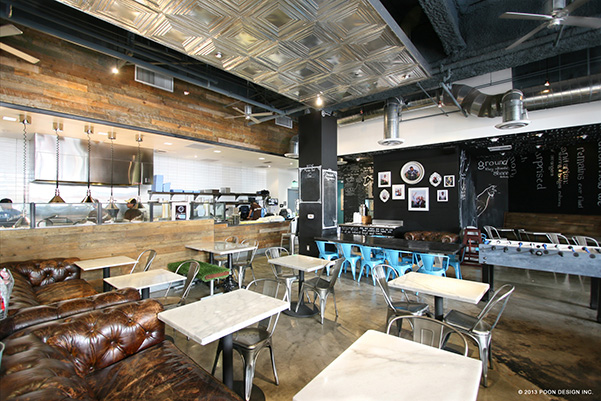 Wood and stone tabletops, as depicted here at Makers Union Pub in Washington, D.C., convey a more natural, authentic experience than laminates, says Jason Maringola, with ZDS Architecture & Interiors. Image courtesy of ZDS Architecture & Interiors.The design of a new restaurant or a major renovation of an existing space should include a thoughtful assessment of how furnishings enhance the overall aesthetic. There are scores of options when choosing shapes, fabrics, patterns, colors, and types of materials used to build furniture. Matching the numerous choices with the desired vibe of the space should involve more than taking a couple of hours to skim through manufacturers’ catalogs.
Wood and stone tabletops, as depicted here at Makers Union Pub in Washington, D.C., convey a more natural, authentic experience than laminates, says Jason Maringola, with ZDS Architecture & Interiors. Image courtesy of ZDS Architecture & Interiors.The design of a new restaurant or a major renovation of an existing space should include a thoughtful assessment of how furnishings enhance the overall aesthetic. There are scores of options when choosing shapes, fabrics, patterns, colors, and types of materials used to build furniture. Matching the numerous choices with the desired vibe of the space should involve more than taking a couple of hours to skim through manufacturers’ catalogs.
“Furniture can make or break a property,” says Jason Maringola, director of interior design, ZDS Architecture & Interiors. The right furnishings bolster the vibe, creating a memorable experience that will please guests and make them eager to upload photos to social media. But, if you choose inappropriate tables and seating for a venue, you risk turning off guests to your establishment.
In addition to aesthetics, choosing furnishings requires consideration of cost, durability, cleanability, order fulfillment timelines, delivery schedules and warranties. For best results when choosing furniture, take a systematic approach that begins during the conception of the design.
Happy Joe’s, a 42-site pizza chain, hired a consulting firm for a refresh of its branding and restaurant design that included a deep dive into the company’s history and culture. The consultant’s work included development of a narrative encompassing the chain’s values and customer experience. This project included interviews with franchisees for a ground-level impression of operations and the brand’s links to their communities. After gathering that information, the consultant dove into design aspects including brand colors and decor. “It was a really detailed process,” says Tom Sacco, chief happiness officer, CEO, and president, Happy Joe’s. “It took about 18 months.”
Burger chain MOOYAH recently developed a new prototype that also included a reassessment of branding and the company’s mission to devise an appropriate furnishing program. “We wanted to make sure that our environment matched the brand message,” says Landon Lane, senior director of construction and design, MOOYAH. “We’re proud of our food and its all-natural ingredients. All food is prepared to order.” The company chose chairs, tables, booths, to-go shelving, and a waiting bench constructed with unupholstered, unstained, and unpainted wood, resulting in a look that echoes the natural ingredients in its food.
In contrast to the subdued aesthetic of MOOYAH’s furnishings, a new Washington D.C. Middle Eastern restaurant currently under development by architecture firm Dyer Brown will have a bold design concept accented by the furniture. Kirsten Smith-Sparrow, project manager for Dyer Brown, notes that the bold colors and patterns on the banquette upholstery reinforce the vibe. Another element, ottomans adorned with gold fringe, helps to create a unique look.
In some cases, a chain tailors its furnishings to different locations. Happy Joe’s, a pizza chain geared toward children and families, offers franchisees three tiers of seating. The first and most economical option consists of bare wood. The second tier has some cushioning, and the third features plusher seating including an upscale leather tufted couch.
“In small towns, people are fine with simple wood chairs,” Sacco says. “In places like suburban Phoenix and Nashville, they are accustomed to a different lifestyle and want more upscale seating options.”
Some brands tailor furnishings to the local environment in other ways. While most Happy Joe’s locations feature furnishings with the brand’s yellow and navy-blue colors, some franchisees along the Gulf Coast asked for a wider color palette reflective of their beach community environs. The brand added four or five colors to accommodate these locations, Sacco says.
It’s important to choose materials that are climate appropriate, Maringola points out. “You wouldn’t use mohair on a banquette in Florida,” he says. The Sunshine State’s hot, humid climate would make sitting on lush mohair uncomfortable, but it would be welcome in cold northern climes.
When specifying furniture for overseas sites, brands sometimes must adjust furniture design for the local market. Sacco found that European markets don’t use as much steel for table and chair frames as in the U.S. Instead, they substitute wood and wood composite material for metal. With the switch from metal to wood, Happy Joe’s still wanted a consistent look in its furniture at overseas venues, though. “We had to provide overseas manufacturers with samples of our materials so they could mirror them,” Sacco says.
Material choices have a great impact on the venue’s aesthetics, Maringola says. Wood and stone surfaces convey a more natural, authentic experience than laminates both tactilely and visually, he says. The former are better choices for fine dining. Although laminates can be visually attractive, they are associated with quick-service establishments, Maringola says.
Manufacturers often provide material samples for design decision-makers to examine. They can provide swatches of fabric and pieces of finished wood to bring what appears on a digital screen to life.
For optimal visual interest, ZDS favors furniture with varied materials such as wood-topped tables with metal bases. “Some restaurants have a uniform look with their furniture, but we like to use mixed materials, so the space doesn’t feel flat and expected,” Maringola explains.
In some establishments, furniture helps distinguish different rooms or areas within a space. ZDS is designing a new venue in Washington, D.C., with two distinct areas — a beer hall and a full-service dining room. To help differentiate the two spaces, the firm is specifying two styles of furnishings. Tables with wood tops will go in the beer hall, while marble and stone tabletops are earmarked for the more refined dining area.
After settling on a concept for furnishings, designers typically connect with vendors to assess specific models. Many vendors offer services that help the design team hone their concept and choose the best options for their project. Cultivating ongoing relationships with furniture vendors bears fruit in several ways, Smith-Sparrow says.
“A lot of the time, we provide the vendor with the floor plan,” Smith-Sparrow says. “We also provide the concept and look and feel.” Sometimes, Dyer Brown sends the vendor photos that convey the desired style of a piece. The floor plan and basic design concept help the vendor to narrow the array of choices — including sizes and heights of tables, chairs, and banquettes as well as the materials. Vendors can help steer designers away from inappropriate choices. For example, a vendor might note that a certain type of wood chair has not held up well in high-traffic restaurant environments.
 Happy Joe’s offers franchisees the choice of three tiers of furniture. The top tier, pictured here, includes leather couches and high-end upholstered chairs. Image courtesy of Tom SaccoVendors also help to choose options that best fit a particular budget. “If we specify a stone top, they might tell us that an engineered stone product looks similar to real stone at a better price,” Smith-Sparrow says. On a recent project, the vendor suggested substituting a wood bar toe kick for a metal one. The wood was durable enough for the purpose and saved “a good chunk of money,” Smith-Sparrow says.
Happy Joe’s offers franchisees the choice of three tiers of furniture. The top tier, pictured here, includes leather couches and high-end upholstered chairs. Image courtesy of Tom SaccoVendors also help to choose options that best fit a particular budget. “If we specify a stone top, they might tell us that an engineered stone product looks similar to real stone at a better price,” Smith-Sparrow says. On a recent project, the vendor suggested substituting a wood bar toe kick for a metal one. The wood was durable enough for the purpose and saved “a good chunk of money,” Smith-Sparrow says.
When choosing a vendor, whether one that makes furniture based on an existing catalog or one that creates custom pieces, some brand decision makers make it a point to tour vendor factories. Lane traveled from his home base in Tennessee to the Ohio factory of a prospective vendor. He was won over by the manufacturer’s attention to quality craftsmanship and their use of natural American hardwoods. “They also had a focus on sustainability and giving back to their community,” Lane says. “They are a great partner for us.”
As high-traffic spaces, restaurants require commercial grade furniture — a tougher, more durable class of products than those intended for residential use. For a brand such as Happy Joe’s that caters to families with young children, durability and cleanability are especially key qualities. When the brand’s consultant met with franchisees, they got an earful about the importance of selecting furniture that stands the test of time. “An inexpensive finish would be okay, but not inexpensive, inferior craftsmanship,” Sacco says. Chairs and tables had to have heavy-duty joinery that could handle some abuse. That said, the brand does offer leather couch seating that is more vulnerable to damage than wood. To lessen wear, the brand encourages franchisees that choose the leather option to steer parties with the youngest children away from those seats.
“You want furniture to last at least three to seven years,” Maringola says. “A lot of times, restaurant refreshes happen at the five-year mark and that’s when clients make replacements.” Quality of craftsmanship is critical. “Quality doesn’t mean costly, it means constructed well,” Maringola says.
Ideally, a project’s construction schedule and the expected time to receive furniture shipments are harmonized. The furniture order should be received toward the latter days of the space’s construction. When sourcing an order overseas, allow for longer lead times. “Time for transport has to be figured in,” Smith-Sparrow says. “Overseas custom orders could take six months or so. Normally, domestic orders take three to four months.”
Supply delays attributed to the pandemic have eased over the last couple of years, Lane says. Recent orders for MOOYAH’s new venues have required about an eight-week lead time. “That’s very reasonable, considering it takes about 12 weeks to build out a restaurant.”
There are plenty of options to find the most suitable furnishings for a restaurant and many vendors to provide them. Approach the choice with the same diligence as the overall design of your space and you will find furniture that best represents your brand.



